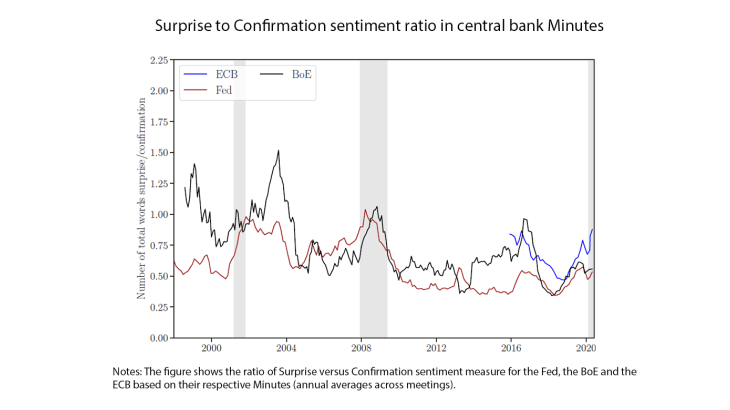The purpose of this paper is to examine how central bankers communicate their confidence and uncertainty in their policy deliberation process. To this aim, we analyze similarities and difference in the Minutes of the Federal Reserve (Fed), the Bank of England (BoE) and the European Central Bank (ECB). Central bank minutes provide detailed summary of the policy discussions and deliberations in the meeting and are, therefore, richer in information than policy statements. Our analysis comprises the period 1993-2020 for the Federal Reserve, 1998-2020 for the BoE and since 2015 for the ECB.
To our aim, we first build text-based measures of central bankers' confirmation and surprise or uncertainty, as communicated through Minutes. To arrive at these measures we construct bespoke dictionaries of terms that policymakers use to express confirmation of their expectations but also to express surprise and uncertainty for what has been going on. These dictionaries are based on our reading of several Minutes from the three central banks, further enriched with machine learning techniques. With these dictionaries in hand we use computational methods to build measures of sentiment for Surprise and Confirmation. These are based on the count of the occurrences of our keywords in the deliberation part of the Minutes (relative to the total words used in the respective section of the Minutes), for each central bank, at meeting frequency. The deliberation part of the Minutes constitutes the space in the Minutes that is dedicated to the policymakers’ views on economic developments and the rationale for the policy decision.
We find that policymakers tend to express more confirmation than surprise in the Minutes, and more space is dedicated to ongoing trends and less to past expectations (either when they are confirmed or not). Our results suggest that this communication has a forward-looking nature, confirming the general belief that policy deliberation is based on forward-looking elements and that there is a preference for highlighting continuity in monetary policy. Surprise and Confirmation sentiment measures fluctuate over time, consistent with episodes of relative economic tranquillity and volatility.
Finally, we show how the Fed, the ECB and the BoE's communication of surprise and confirmation relate with monetary policy decisions. We find that the sentiment of the committee whether the economy is evolving as expected or not is informative about the policy stance, above and beyond of what the macroeconomic data suggest. More precisely, a higher communication of Surprise is associated with a higher likelihood that the policy will ease in the coming meetings (controlling for the inflation and GDP growth projections). In contrast, confirming trends rather increases the likelihood of a tighter policy stance. These findings tie well with the sources of surprise (economic activity) and confirmation (inflation) that we identify in Minutes.
